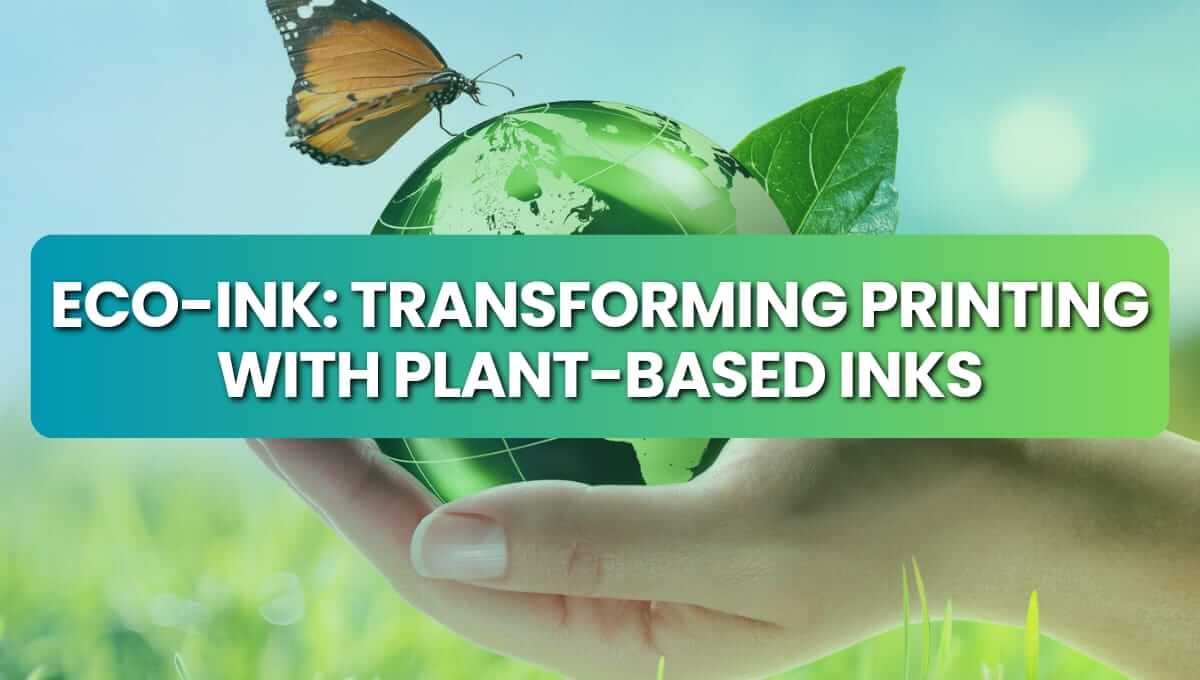Eco-ink: Transforming Printing With Plant-based Inks

With technological advancement, consumers focus on their buying choices and how they impact the environment. Every industry is finding unique and sustainable alternatives to stand out.
These innovations play a vital role in transforming the packaging industry and a healthier ecosystem.
This blog will discuss eco-inks and how they make product packaging visually appealing. Keep reading to learn more because these greener alternatives are a step towards a sustainable future.
What Is Eco-Ink?

Eco-ink is commonly known as plant-based ink. It has shown transformative shifts in the printing industry with high-quality prints. Generally, traditional inks are made from two primary components.
- Petroleum-based products
- Synthetic chemicals
But that's not the case for eco-inks. They are carefully derived from only renewable sources. Natural ingredients make eco-inks nontoxic. It's mainly due to their composition that the environmental impact, especially from production to disposal, is minimal.
The biggest advantage of this shift is that you can rely on something other than non-renewable resources. Printing with eco-friendly inks minimizes ecological footprints, aligning with global environmental goals and improving the printing process.
Types Of Plant-Based Inks
Eco-inks were initially introduced in the 1970s, and the first commonly known alternative was soy-based inks. After that, several technological advancements resulted in the experimentation of a wide range of plant-based inks.
These researches have opened room for innovation and sustainability. Here are some of the most well-renowned plant-based inks you should know about and the range of printing applications.
Soy-Based Inks
You can tell by the name that they are derived from soybean oil. This eco-ink is widely used primarily because of its bright colours and ease of use. It offers clarity and has high printing quality.
That's why it's a popular choice for images and brochures. You often see it in newspapers and magazines because it's used in various printing processes.
Algae-Based Inks
Algae-based inks are manufactured from algae, a renewable resource that can be cultivated in varying environments such as saltwater and wastewater. This ink is notable for sustainability as algae grow quickly with minimal resources. Since eco-ink can produce various colours, it's suitable for both standard and specialty printing.
Algae-based inks have a very low environmental impact. Additionally, algae can be harvested without competing with food crops.
Other Plant-Based Alternatives
There are many plant-based alternatives, but they are not widely known. They are incredible in terms of performance and quality, but still, there is room for improvement. These plant-based inks are still under development, and researchers are doing their best to refine them further.
- Linseed (Flaxseed) Oil-Based Inks: Extracted from flaxseed oil, these inks provide durable, biodegradable prints. They are often used in fine art and packaging.
- Corn-Based Inks: Derived from corn oil, with fast drying and consistent colour. It is used in packaging and promotional materials.
- Safflower and Sunflower Oil-Based Inks: Made from these oils, offering stability and a long shelf life. It is used in commercial printing and packaging.
Benefits Of Plant-based Inks
Using plant-based inks can contribute to environmental sustainability and better business practices. These sustainable practices are the future of printing.
Using eco-friendly ink offers a range of benefits and contributes to a circular economy.

Focus on Environmental Sustainability
By now, you already know that plant-based inks are made from renewable resources. They reduce the burden on non-renewable resources and help in proper conservation. However, the major issue is that traditional petroleum-based inks emit a lot of greenhouse gases, especially when compared to plant-based inks. Ultimately, this leads to the destruction of the natural atmosphere and adverse climate change.
Plant-based inks easily combat this problem because they are biodegradable. This means they break down easily in the environment, reducing long-term pollution. Volatile organic compounds (VOCs) are toxic chemicals present in traditional inks. But are they present in plant-based inks?
No.
That's how they reduce air pollution and health issues.
Top-notch Quality Of Prints
You want the printing to look high-quality, right?
But if the colour starts fading or doesn't match your brand's signature sign, that can be a huge problem. Plant-based inks resolve this problem because the colour is vibrant and sharp.
These inks absorb better into paper and lead to consistent print quality and less smudging.
Saves A Lot Of Money
To make a business successful, you must tactfully evaluate and strategize your money. With plant-based inks, upfront costs can be high. However, it provides more rewards in the long run and reduces environmental impact. Here are some of its advantages:
- Reduced environmental compliance costs
- Potential tax incentives
- Lower health-related expenses
Most traditional inks are unstable, so you must use a lot of ink to achieve high-quality results. Meanwhile, less ink is required in plant-based inks, and you'll still get the same quality results that improve your business perception.
Attract Target Audience
Understanding your customer base is critical to selling any product to them. The number of eco-conscious customers is increasing, and with plant-based inks, you can market your business as environmentally responsible. This immediately attracts customers' attention.
Due to climate change, the government is even making efforts to formulate laws to regulate industries' environmental impact. Implementing these will protect your business from current and future regulations, avoiding potential fines and legal issues.
Plant-Based Inks vs Conventional Inks
There's a significant difference between plant-based and conventional inks. They vary greatly in terms of environmental impact, health, overall performance, and raw materials.
So here's a quick overview of how these inks differ. It'll help you understand which one is best for your business.
How Can You Transition To Sustainable Inks in Your Business?
To switch to sustainable inks in your business, you need to stop using petroleum-based inks. Be extremely cautious about using remanufactured ink cartridges and toner cartridges. They have a negative impact on the environment and contribute to climate change.
So, sustainable plant-based inks are the most effective method to transition to sustainable printing.

The oil content of ink should not contain any petroleum ingredients. The plant-based inks mentioned in this article are eco-friendly alternatives. Here's what happens:
Remanufactured Toner + Printer Cartridges = Reduce The Carbon Footprint + Impact On Natural Resources
Some people are also confused about cartridges. So is it a good choice?
People respond differently to remanufactured ink cartridges but generally employ relatively less traditional ink than standard cartridges.
How To Choose Which Ink Is Most Suitable?
When choosing the most suitable ink, consider some factors. First, you need to know about eco-inks and their different types. Then, choose the printing methodology you want to implement. It utilizes renewable materials without compromising the colour intensity of prints.
Some of the most common printing methods are:
- Offset
- Flexographic
- Offset lithographic
- Digital toner
- Digital inkjet
- Screen printing
After finalizing the printing method, you should move to the next step, choosing the printing substrate. There are a variety of substrates, some of which are listed below:
- Uncoated paper and corrugated
- Coated paper and corrugate
- Plastic
- Glass
- Aluminium
Now, clarify the printing requirements, such as durability, colour, and quality. Make a list of all the things you want to accomplish with printing, such as sustainability, customer attention, etc. Then choose eco-inks made from renewable sources with low volatile organic compounds.
Consider the cost associated with plant-based inks and then weigh the pros and cons of each. Lastly, don't forget to focus on market appeal—after all, printing aims to get attention from your customers. Choose ink that aligns with your brand messages and showcases your efforts towards sustainability.
Solvent-based inks cause severe ink wastage and emit harmful greenhouse gas emissions. Check carefully to ensure you are not using harmful solvents that contradict sustainability goals.
Ending Thoughts
It won't be wrong to say that eco-inks are the future of sustainable printing. They are also cost-effective because they are made from abundant resources. Green printing inks are nontoxic and biodegradable.
However, some organic inks contain a slight amount of VOCs and heavy metals. In comparison to conventional substrates, their environmental impact is very low. That's why, before printing, you need to know the nitty-gritty of eco-inks and their impact. You can also try vegetable-based ink, a good alternative to petroleum inks.
Want to know more about packaging and printing?
Check out our detailed blogs here. We have made premium guides on levelling your business through labels, packaging, and printing.
